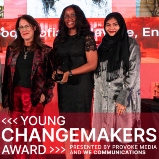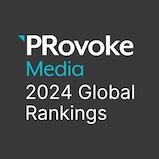Holmes Report 14 Jun 2013 // 11:00PM GMT
“The empires of the future are the empires of the mind,” Winston Churchill
The beauty of seeing around corners and envisioning the future is that it allows for the mind to catch up with the soul. The areas cited below represent what we see taking place in organizational communications, albeit in either a small sample or a much greater cohort. They are meant to inform, provoke, and perpetuate discussion within your organization to ensure employees remain engaged, active and knowledgeable.
1) Analytics move inside and disrupt the status quo
Becoming smarter about the business through sophisticated communications-directed analytics is quickly becoming the norm. From identifying conversation influencers inside and outside of the company to understanding the extent organizational or brand knowledge impacts reputation, to creating fresh content and new engagement models, analytics presented via dashboards inform and re-direct Corporate Communications priorities based on current community realities and deeper research.
2) Employee archetypes refine engagement and communications strategies
Long dead is the concept that your workforce is a homogeneous entity meaning content, cadence, and frequency is a “one-size-fits-all” proposition. Employing analytics is a key tool in discerning the behavior and attitudes that exist within the company. Knowing your specific employee archetypes equips Communicators to drive clarity and increase engagement among the workforce. Worldview Analytics offered through our Mettle corporate analytics team reveals four types of archetypes found within most organizations:
• Passionate Preservationist: Career oriented/strong company pride, respectful of status quo. This group tends to be long-time employees who have had successful careers in the company. They are highly engaged but often blind to the opportunities and gaps inherent in the culture and business. They are also more often than not the ones who state in meetings that "we tried that before and it failed," or "good idea but won't work here."
• High-energy Catalyst: High potential/high achievement, catalyst for change. This if often the most powerful group in any organization. They are high potential, talented and committed to winning, but can be frustrated by inertia and perceived lack of discipline and commitment to change. This is the key target for any leadership and internal communications effort!
• Productive Minimalist: Productive/satisfied. A large population of the workforce sits here—they come to work every day, do their jobs, and are generally satisfied with the way things are.
• Denigrator: Marginally effective/highly critical, “victim” mentality. Typically the smallest group within a workforce but also the most dangerous in terms of culture deterioration. These folks tend to gossip the most, work the minimum and trash every company decision to people both inside and outside the company.
The problem today is that many organizations are communicating to a workforce that doesn’t exist.
Comprehending the archetypes that comprise your workforce is important to generating content that truly connects with people on their terms so as to encourage discussion, dialogue and debate. All of which leads to stronger and more consistent engagement.
3) Employees see through different lenses
Due to diverse digital and social tools, employees can tailor how they engage with internal platforms – not just the tools they use, but also the content they access such as specific data, graphics, videos, communities, etc. Such customization is both an opportunity and challenge for organizational communicators. It starts with creating an intuitive and relevant portal designed to aid productivity and achievement, which can be better informed by archetyping mentioned above. From here, a complete mosaic can be crafted enveloping the employee’s work experience.
4) Worldview matters; awareness doesn’t
How and why an employee perceives the business the way they do matters more than ensuring they are aware of any given information. When their experience and perceptions are understood, communications and management approaches can be recast as necessary and/or aligned to create a consistent, clarity-improving experience. Analytics play a huge role here as well and can help discern the mindset of your workforce more easily than before. Worldview™ Analytics for example reveals how employee communities think and can result in a composite profile that allows leaders and communicators to tailor content accordingly.
5) Collaboration can drive behavior change (if practiced by leader)
The proliferation of collaboration-oriented platforms (Jive, Yammer) is causing leaders and managers to examine how they communicate and build engagement among their staff. It is also causing them to rethink how they lead and manage. Increased opportunities to communicate across boundaries (geographies, titles, time zones, etc.) encourage e valuable discussions, dialogues and debates to occur about topics, issues, and policies that matter most to businesses. Confidence across the organization increases and often decision-making is accelerated as a result. Essential to achieving this success, however, is if and how leaders and managers incorporate this technology into their respective management models.
6) Content must be agile to inform multiple platforms
In order to break through the clutter, capture attention and spur action, content must be flexible so it can be shared across multiple platforms (print, broadcast, visual, electronic, digital social) and successfully reach intended audiences. Gone are the days where one-size-fits-all content is effective.
7) The Age of Context
People can largely access “the facts” anytime, anywhere. In this sense, business content has become commoditized. What is rarer, however, is context – content that connects the dots and provides deeper meaning and insights for employees Instead of simply announcing a decision, incorporate the “why?” This places much more responsibility on corporate communications to be involved in the business of the business and to counsel leadership in communicating the rationale behind key decisions, which can in turn be shared with employees.
8) Employee Engagement is a multi-part solution
With all the talk about engagement, the dirty little secret is that true employee engagement is the result of multiple factors and part of a bigger system, including recruiting, orientation, job design, goals and expectation setting, managerial interaction, performance metrics, knowledge sharing, collaboration, reward and recognition, and professional development, to name a few. Focusing just on HR or Communications is a prescription for failure. Instead, that means corporate communications should be collaborating across multiple corporate functions to assure continuous alignment.
9) Most Reputation and Trust Metrics show you the destination without mapping a way to get there
Unfortunately, much of what Reputation and Trust research focuses on today either is a combination of traditional media and stakeholder feedback or an unwieldy list of characteristics meant to find the Holy Grail. Either way, leaders are left with knowing the gaps but without comprehending the connectivity.
Analytics are providing a wider aperture from which to view Reputation and Trust providing leaders and communicators with actionable insights from which to make smarter decisions about the myriad elements impacting each. For example, Reputational GPS™ model developed by Mettle® allows organizations to customize the characteristics critical to their business and industry beyond just media traditional sources, resulting in specific operational actions as opposed to utilizing an array of unwieldy general tenets that lead nowhere.
10) New platforms enhance clarity and encourage comprehension: From Capsules to Corporate TV
From capturing an entire story around a major business initiative to enhancing a brand’s heritage, new platforms such as W2O Group’s Change Content Capsule powered by Nextworks are allowing CEOs and CCOs to achieve new levels of clarity among the workforce by shaping business information (such as strategy, organizational changes, or initiatives) into cohesive, focused stories instead of random data and disparate information (see below).
Additionally, global organizations are also reinvesting in their own in-house Corporate TV programming as a means of telling their story to employees while at the same time involving them in the process and the production. Corporate TV, so to speak, can be produced relatively inexpensively, loaded onto multiple platforms and cadenced throughout the day, week, month.
11) Visual trumps copy (almost always)
Research tells us that a growing number of people are visual learners, that is, they respond much better to videos, pictures, graphics and visuals than to the written word. Knowing this, marketers and communicators are redesigning their strategies and approaches to better balance programming to reflect this reality. This shift is breathing new life into both iconic brands and business-to-business as well. More than just YouTube, envisioning content visually opens up completely new ways to grasp information and accelerate learning.
12) “Storytizing” personalizes business strategy (Change Content Capsule)
One of the more challenging aspects of a CEO’s responsibility is gaining and maintaining organizational clarity around key priorities, objectives and goals. In 2013, our firm commercialized with Nextworks the Content Capsule, a breakthrough in storytelling, or what we like to call Storytizing. The premise is that it doesn’t make sense to spend resources to drive people to a website or social channel when you can creatively package content for specific audiences and deliver it directly to your customers.
The Content Capsule decreases focus on clicks and increases focus on relevance. Content Capsules can be embedded in websites, blogs and paid media. Every interaction with each piece of content is monitored and measured. Insights drawn from analytics can be used to update capsules in real-time while they are in distribution. Picture programming thousands of screens across the digital ecosystem—the web, mobile, social—in direct response to employee interactions, provides an outlet for employees write their own story and to see it through their eyes, thus increasing people’s ability to learn, listen and engage.
13) CEO Provokes Conversation and Debate Internally
The CEO as provocateur fits a growing trend among senior executives to be the catalyst for change within their organizations. This shifts rhetoric from a traditional “cheerleading” platform to one that prods, pushes, and probes the business for innovation, debate and better ways to serve customers and manage employees. It changes the very tenor and style of interaction inside the business, unleashing a constructive form of dialogue that permeates every crease and crevice.
The year ahead – big data meets new insights to form break-through solutions
It appears that 2013 is the year where CCOs fully embrace data and analytics as means to solve challenging organizational issues such as clarity and employee engagement. The new insights gleaned from the analytics can provide fresh new avenues to explore while new platforms allow for a more heightened experience by employees around key issues and topics impacting the organization.
The first step, however, begins with appreciating and employing analytics in everything the Communications Function undertakes. From there it’s about translating the data into actionable insights opening up new ways to think about and address organizational behavior. This leads to creating new content – informational, advisory or entertainment-based – directed at multiple (and new) platforms.
The overarching benefits or results point to a new reality: employees are ready, willing and able to change and make a difference in the company’s future if the right information, content, context, and interactions are put in place.
So what are you waiting for?
Gary F. Grates is principal at W2O Group, an umbrella organization directing a network of analytics-based marketing, communications and digital consulting firms such as WCG, Twist Marketing, W2O Digital, BrewLife, and W2O Ventures. He oversees the corporate and strategy portfolio and is an expert in employee engagement, internal communications and change management.



































.jpg)

















